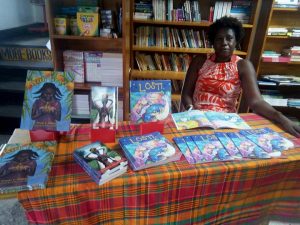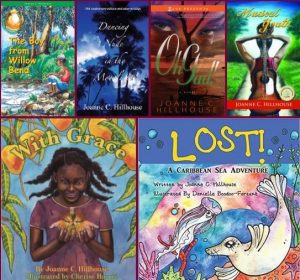Are Children’s Books Real Books?

Book signing event at local Antigua bookstore, the Best of Books.
I’m being facetious obviously. Because, hell yeah. But I’ve seen the way people react or don’t react when you mention that your book in progress or recently published book is a…children’s picture book.
Most recently, someone contacted me to find out if I’d written any new books. Before I could twist my mouth to mention my two most recent books, With Grace and Lost! A Caribbean Sea Adventure, he added, “not the children books” – in a tone that suggested, not those, real books. I’ve encountered this a few times, and, really, what can you do but smile and keep writing?
I mean, I get it. Children’s picture books are a very specific market: parents and, on Christmas and birthdays, anyone with children in their life. But if we think about the fact that we were all children once, we’d realize that children’s picture books are the only truly universal books in this whole publishing game – we’ve all sung an ABC or been enchanted by a faerie or Anansi or other folk tale, heard a bedtime lullabye or two. So can children’s picture books get some love?
Ironically enough, when my first book The Boy from Willow Bend (a story about a boy though not written as a children’s book) dropped, I got hung with the children’s author label (even after my second book Dancing Nude in the Moonlight dropped). It felt confining to my publishing brand and my creative spirit. Publishing loves its categories and I wrote everything, as my writing and publishing record since continues to illustrate. And yet I was excited to receive recently an invitation to participate in a children’s book panel at a major American book fair. The publishing gods have a sense of humor because here I am embracing a label I worked for years to shake.
Part of the reason I wrote my first children’s story was so that I could have a story of my own to read when I attended events (‘children’s author’ Joanne C. Hillhouse had no age appropriate material) – it was a branding (or rather lack-of-branding) issue. Reading an early draft of that first children’s story to children (once during a school visit, once at the children’s reading club with which I volunteered) and editing it based on their reaction actually helped me get it to a pretty publishable place (children at that impulse st/age don’t know to be polite, they just react). So that when I saw a publisher call for material for new children’s books I had something to submit.
That first children’s picture book publishing experience was less than ideal in a number of ways (thank the publishing gods that the book got a second chance with a new publisher and re-emerged as Lost! A Caribbean Sea Adventure). But that first round did educate me about editing a story targeted at children.
There was even a reading specialist involved at one layer. At this layer, you’re scrutinizing word choice, sentence length and structure, story structure, descriptions, plot points, and more based on the targeted reading level. Questions like concrete and abstract thinking and how and when these develop in children and how responsive the story is to these realities relative to the target group come up. It was a struggle for a writer who, to then, had operated from the instinctive and crafting place of whatever serves the story.
With another of my picture books, With Grace, I also found myself having to think about the tropes of that particular sub-genre (i.e. the fairytale). Tropes are the common elements of a particular genre and can be stifling, but in order to bend the rules you first have to understand them. For me playing within the tropes and colouring outside the lines as much as I could was another opportunity to experiment. And, as a writer, I love to experiment.
 With Grace, which began out of a need for emotional exorcism before revealing itself to be a gestating fairytale, got the opportunity to be workshopped blind as I slipped it in among the material to be critiqued during a pre/teen workshop I was running at the time. In time, I had something submittable and the story went to a contest, earned commendation, and attracted publisher interest.
With Grace, which began out of a need for emotional exorcism before revealing itself to be a gestating fairytale, got the opportunity to be workshopped blind as I slipped it in among the material to be critiqued during a pre/teen workshop I was running at the time. In time, I had something submittable and the story went to a contest, earned commendation, and attracted publisher interest.
My third potential picture book – currently being shopped by my agent – was sparked during a conversation with my nephew. As with any kind of book, the inspiration is life and the imagination.
I have found the journey of writing children’s picture books no less challenging and fulfilling than writing the other things I continue to write and publish. Sure they have their limitations, what doesn’t? You still have to write something that’s creative, engaging, foundationally strong plot and character-wise, and you have to do that in fewer words with more limited vocabulary, while keeping the beauty of the language, and getting the tone right. As we would say in Antigua, easy my big toe.
Joanne C. Hillhouse’s published books of fiction are The Boy from Willow bend, Dancing Nude in the Moonlight (now, Dancing Nude in the Moonlight 10th Anniversary Edition and Other Writings), Oh Gad!, Musical Youth, and the two children’s picture books Lost! A Caribbean Sea Adventure and With Grace. Her writing (fiction and poetry, and her articles) continues to travel far and wide from her home country of Antigua and Barbuda. Find her online at http://jhohadli.wordpress.com
Category: Contemporary Women Writers, How To and Tips
























Great post and I really appreciate your post. There are numerous little approaches to grow your reality. The adoration for books is the awesome all.
Children’s literature is one of the most important tools in every child’s developmental process. It provides them with so many benefits. First, it could be a way for them to respond to literature. Second, it helps them develop a lot of cognitive skills, demanding kids to think. Lastly, it will teach them many life lessons, in which they can carry out all their lives. You may also check my blog about Guide to Writing a Touching Children’s Book Hope this will help. Thank you.
Thanks for pointing out that children’s books are the only truly universal books in the publishing game. My son is getting to the age where he can start learning how to read, and I want to promote this healthy habit. I’ll start looking for children’s books for my son so he can get some practice in with reading.
Very nice post and I enjoy reading your article. Writing for children is bleeding troublesome; books for kids are pretty much as unpredictable as their grown-up partners, and they ought to thusly be agreed on similar regard. Thanks!
Children’s books are so important, and in many ways, MORE important than the books we read as adults because they can influence the types of books read… or if reading becomes a lifetime habit.
I’m not a grandparent yet, (side-eye glare at my three children) but books are the only gifts I give my fifteen grandnieces and nephews. Some of them are now providing me lists of their book choices. 😊
Excellent article!